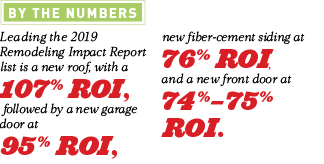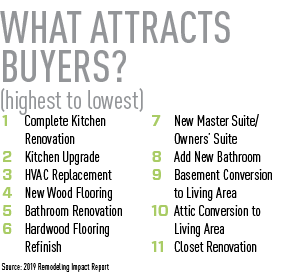Guide sellers to home improvement projects for which buyers pay top dollar
By Donna Shryer
The decision to sell one’s home is often fraught with emotion—but it’s the next decision that usually packs the biggest wallop. Refresh and repair? Remodel? Renovate? What needs to be done and how much does it cost to prep a home for sale? More importantly, which home improvement projects deliver the highest return on investment? Conversely, which home improvement projects will have buyers saying, “Are you nuts? I’m not paying an additional $15,000 for that!”
Fortunately, your sharp market insight combined with the 2019 Remodeling Impact Report, a joint study from the National Association of the Remodeling Industry (NARI) and the National Association of REALTORS® (NAR), makes for a perfect duo to help guide sellers toward projects that make the most sense relative to cost.
The study analyzes 12 interior and 10 exterior home improvement projects, crunches the data and delivers average project costs, likely buyer appeal and estimated return on investment (ROI) when homeowners sell their home.
Changing with the times and numbers
REALTORS® who command up-to-date data on average home improvement project costs, buyer appeal and estimated ROI are part of the trending multidisciplinary approach to real estate. The trend to blend capabilities goes as far as you want it to.
With a remember-when grin, Wheaton, Illinois-based Karen Parent, CRS, REALTOR®, RE/MAX Suburban, says, “Once upon a time, prepping a home for sale meant putting a lockbox on the front door. Now I’m involved long before the home is listed. Sellers rely on my experience to help choose home improvements that buyers want, so the home sells quickly—and that buyers will pay for, so the seller recoups that prep money.”
Serving the greater Seattle market, Gordy Marks, CRS, managing broker, Gordy Marks Real Estate RE/MAX Northwest REALTORS®, recommends and foots the bill for certain essential home improvement projects. “In our area—technology central—buyers often have more money than time, so turnkey homes sell for the highest dollar per square foot. That means it’s important that we take on what needs to be done—to ensure everything is done right,” Marks explains. Projects he and his team schedule, oversee and finance include landscaping, pressure washing, window washing and professional house cleaning. For bigger-ticket improvements that still fall within high-ROI territory, it’s the seller’s choice, although Marks simplifies the project process by having a list of vetted tradespeople at the ready.
Pointing to how far and wide a CRS’s multi-disciplinary approach to real estate can go, there’s Mark Green, CRS, broker associate with Real Living Real Estate Professionals, serving the Northern California market. In addition to having been a broker since 1993, Green is also a licensed contractor. “Having both licenses helps me understand what a seller can do with the least amount of hassle and highest return on their investment. My experience as a contractor also gives me a unique list of resources—tradespeople I know can get a job done right at the right cost.”
And the Winners Are…
According to the 2019 Remodeling Impact Report, here are the projects that came in with at least 75% ROI at resale.
Exterior Winners
New roofing:
NARI Remodelers’ cost estimate: $7,500
REALTORS® estimated cost recovered: $8,000
Estimated ROI: 107%
New garage door:
NARI Remodelers’ cost estimate: $2,100
REALTORS® estimated cost recovered: $2,000
Estimated ROI: 95%
New fiber-cement siding:
NARI Remodelers’ cost estimate: $19,700
REALTORS® estimated cost recovered: $15,000
Estimated ROI: 76%
New steel or fiberglass front door:
NARI Remodelers’ cost estimate: Steel: $2,000;
Fiberglass: $2,700
REALTORS® estimated cost recovered: Steel: $1,500; Fiberglass: $2,000
Estimated ROI: Steel: 75%; Fiberglass: 74%
Interior Winners
New wood flooring:
NARI Remodelers’ cost estimate: $4,700
REALTORS® estimated cost recovered: $5,000
Estimated ROI: 106%
Hardwood flooring refinish:
NARI Remodelers’ cost estimate: $2,600
REALTORS® estimated cost recovered: $2,600
Estimated ROI: 100%
HVAC replacement:
NARI Remodelers’ cost estimate: $8,200
REALTORS® estimated cost recovered: $7,000
Estimated ROI: 85%
Insulation upgrade:
NARI Remodelers’ cost estimate: $2,400
REALTORS® estimated cost recovered: $2,000
Estimated ROI: 83%
Source: 2019 Remodeling Impact Report—a joint study from the National Association
of the Remodeling Industry (NARI) and the National Association of REALTORS® (NAR).
A few take-home points
Let’s examine the 2019 Remodeling Impact Report, less as a list and more as a compass. Here are several overarching directions that will help you interpret the report’s data and guide sellers toward home improvement projects that buyers will pay for.
Think outside the box
Whether you call it curb appeal or an exterior project, the 2019 Remodeling Impact Report says it all: ROI averages for exterior replacements and improvements outperformed larger discretionary interior remodeling projects. Leading the list is a new roof, with a 107% ROI, followed by a new  garage door at 95% ROI, new fiber-cement siding at 76% ROI, and a new front door at 74% to 75% ROI.
garage door at 95% ROI, new fiber-cement siding at 76% ROI, and a new front door at 74% to 75% ROI.
Remodeling magazine’s 2019 Cost vs. Value Report confirms curb appeal’s continued worth. The report, which compares the country’s most popular remodeling projects’ costs vs. how much the investment will improve a home’s resale value, ranks garage door replacement first, with an average 100% ROI at resale. Next up is a manufactured stone veneer project, averaging a 95% ROI. In fact, 9 of the top 10 high-return projects detailed in this report happen outside.
“That old saying, ‘You can’t judge a book by its cover,’ doesn’t translate to real estate,” Marks says. “So our role is to guide sellers toward important home modifications that begin in the front yard.”
Walking the fine line
An ongoing discussion between REALTORS® and sellers concerns interior design trends and how much to acknowledge them when prepping a home for sale. One school of thought is to give homebuyers an HGTV-approved presentation. “We’ve seen homebuyers’ expectations change. They want homes to look like the TV shows they binge watch,” says Jessica Lautz, doctor of real estate. “But those glamorous projects have a low ROI. So here’s where the listing agent plays an essential role.”
Dr. Lautz is referring to REALTORS® with professional stagers on speed dial—experts who create on-trend design masterpieces. According to NAR’s 2019 Profile of Home Staging report, this is a project with a big ROI.
- 40% of buyers’ agents cited that home staging had an effect on most buyers’ view of the home.
- 83% of buyers’ agents said staging a home made it easier for a buyer to visualize the property as their future home.
- The rooms most commonly staged included the living room (93%), kitchen (84%), master bedroom (78%) and the dining room (72%).
Everything shipshape
Remember the interior and exterior projects with top ROI? Flooring, HVAC, insulation, roofing, garage door, fiber-cement siding and front door. The modifications are about as unsexy and plain-vanilla as it gets. But it’s what millennials want, and according to the NAR 2019 Home Buyers and Sellers Generational Report, sellers would be wise to cater to these buyers—since they made up the largest share of homebuyers in 2019, at 37%. The report goes on to say that 51% of buyers who were 29–38 years old, aka older millennials, bought new homes specifically to avoid renovations and problems with things like plumbing or electricity.
“The generation coming up isn’t interested in expensive maintenance repairs. If the home inspector says something’s not going to work in five years, they want it replaced now,” Parent says. Focusing on the roof, she adds, “More than anything else, I’ve had more buyers walk away from a home because it may need a new one.”
Even if that new roof or HVAC system jacks up a home’s price, more buyers than ever are okay with that. “People don’t want to take on these projects. They’re messy, loud and expensive. So sellers get a lot of bang for their buck if they take on these kinds of projects,” says Jessica Lautz, doctor of real estate and NAR vice president of demographics and behavioral insight.
Refresher course
If you want to shine brighter than a stainless-steel Sub-Zero Pro 48 refrigerator, tell your sellers that complex, expensive and time-consuming renovations are so yesterday. Today’s buyers are willing to pay for less luxury, providing everything works as it should, will continue to work for a reasonable amount of time and looks good.
To zoom in on an example, let’s look at the kitchen. The 2019 Remodeling Impact Report puts a complete kitchen renovation at $60,000, with a cost return of $40,000 and an ROI of 59%. A kitchen upgrade, still costing a pretty penny, comes in with an even lower 52% ROI.
Here’s where things get interesting. The 2019 Cost vs. Value Report offers a third kitchen improvement option, the “Minor Kitchen Remodel/Midrange,” with a $22,507 cost average and an estimated 80.5% ROI. Geared to a functional but dated kitchen, improvements include replacing cabinet box fronts and hardware, countertops and flooring, and installing a new cooktop/oven range, slide-in refrigerator and mid-priced sink and faucet.
“Minor remodels, regardless of the room, are preferred,” says Shelley Watkins, CRS, associate broker-REALTOR® with LAH Real Estate in Birmingham, Alabama. “Anything more complex throws the budget, timeframe, ROI and emotions out of control,” she says.
By emotions, Watkins means that sellers often slip into creating their dream kitchen, bathroom or master suite—forgetting that the project is to help them leave the home faster and with more cash in their pocket. “That $500 light fixture may be beautiful and something they’ve always wanted, but buyers won’t pay for it. It’s my role to make it clear that the $100 fixture will do just fine for a refresh, it looks great and the return will be higher,” Watkins says.
Brush Up on the Facts
Individual room and full interior paint projects are both featured in the 2019 Remodeling Impact Report—but there’s no ROI. “We don’t have a cost recovery because painting is often DIY. However, a fresh coat of paint is always a good place for a seller to start,” says Jessica Lautz, doctor of real estate.
In full agreement, Watkins goes a step further. “We’re hearing about a strong trend toward vivid colors and deep tones, but it’s a neutral palette that sells houses.”
If your seller insists on going with coral walls and ochre flooring because Chip and Joanna Gaines say so, don’t stress it. Green has a tip. “Take your seller to see the top three comps in their neighborhood. Let them see for themselves the freshly painted, neutral-colored walls.” Checking comparables is a strategy Green uses to support any home modification he recommends—whether it’s painting, plumbing, light fixtures or flooring.
Regardless of which reports you read, the truest ROI of any project depends on your market. It’s a fact that strongly supports the REALTOR®’s trending multidisciplinary role in real estate—even when it means asking the seller to make tough choices. “When prepping a home for sale, either do it all the way or not at all. If the seller is only willing to pay for and go halfway, I think you just amplify what’s not yet done,” Marks says. “So sometimes I need to tell people that the smartest choice is to work with the asking price, maybe market the home as a fixer-upper, because putting new slab counters on old, worn-out cabinets is a waste of money. The next owner will only rip everything off to replace the cabinets—and the buyer’s REALTOR® will use that to negotiate a lower asking price. I certainly would.”
Meet your Designation maintenance requirements today! Read this article and “Presentation Perfect”, take a 10-question quiz and earn 2 credits. Go to CRS.com/trs-quiz to get started.








